Ultimate Tensile Strength
Ultimate tensile strength (or tensile strength for short) is an important property of materials to determine their mechanical performance. It is the ability of a material to resist cracking due to stress. This parameter is applicable to all types of materials such as wires, ropes, metal beams, etc.
What is tensile strength?
Imagine a strip of paper that you pull the two ends of with your fingers. You exert a tensile force on the strip. When this tensile force exceeds a certain threshold, the paper tears. The tensile stress at which this happens is the tensile strength of that material, in this case paper.
When excessive tension is applied, both tough and brittle materials will approach a breaking point. Initially, uniform deformation will be observed. Over the entire body of the material, the length will increase while the width will decrease by the same amount.
The ultimate tensile strength is the amount of stress that causes materials to pass from the state of uniform plastic deformation to localized concentrated deformation. The phenomenon of necking begins at this point.
Necking process
The final tensile strength is an intensive property. In other words, it does not depend on the size of the sample. The same material with a varying cross section will have the same value of tensile strength.
Since this type of fracture in a system can lead to failure and potentially endanger lives, it is imperative that this parameter be taken into account when selecting appropriate materials for an application.
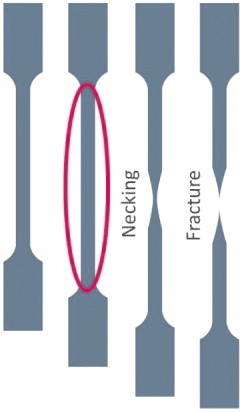
Ultimate Tensile Strength on a Stress-Strain Curve
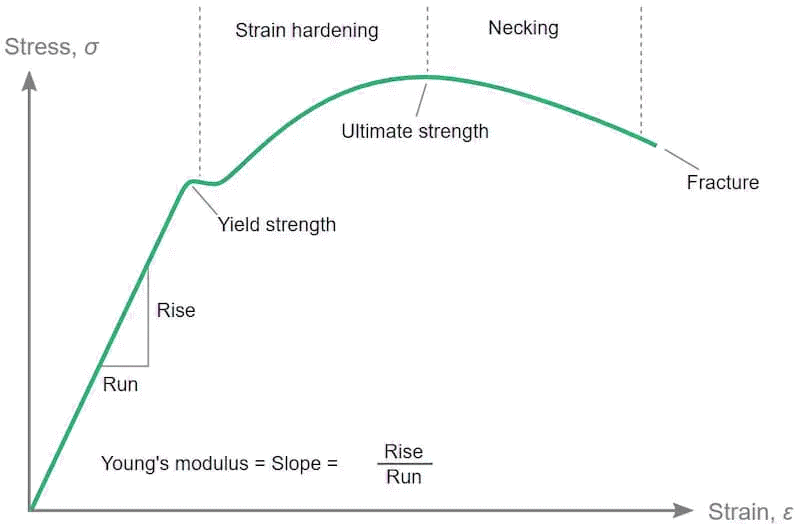
There are 4 main areas into which a stress-strain curve can be divided..
- Proportional limit
- Yield limit
- Strain hardening
- Necking
Proportional limit
In the proportional limit, the specimen material behaves like a spring and any strain induced is fully reversible. On the stress-strain curve, this region is called the Hooke's region. The reason lies in the applicability of Hooke's law for forces that fall in this region.
Yield limit
Once the specimen passes the proportional limit, it enters the region of the yield strength. At this point, permanent deformation occurs. From this point, it does not matter if you release the tensile force or apply a force in the opposite direction, the specimen will not return to its original dimensions.
Strain hardening area
With further increase in tensile stress, the specimen enters the stress hardening region. This is a very unique section because the crystal structure of the material changes. The material is under enough stress that the microstructure itself is altered.
As the name implies, the material becomes harder and tougher. This hardening can be very useful and so is not necessarily a bad thing (cold hardening, cold forming processes actually use this area to impart strength to the workpiece).
Necking area
Just before the necking phase, the material is the strongest it will ever be. The material is stretched to its maximum. When we get to the neck phase, the material begins to weaken. It is characterized by a local reduction in cross-sectional area.
Beyond this point, the material is only going to fail. It can handle less stress with increasing strain.
We can sort of go back to the original equation that says stress is equal to force per unit area and infer that the smaller the area, the higher the stress. The material moves beyond this point until rupturing.
Why Is Tensile Strength Important?
It is imperative to know the tensile strength of a particular metal or any material to ensure it is the right choice for an application. This ensures an incident-free service life.
The results of choosing materials with lower tensile strength than what the application demands can be disastrous.
Engineers turn to yield strength in the design phase to make sure the stress never reaches any higher than that. Otherwise, the structure suffers permanent deformations. But ultimate tensile strength tells us the value that is necessary for complete failure and breaking.
Thus, a roof construction that comes under more stress because of a higher than normal snow load may bend the structure. At the same time, surpassing the tensile strength value means that the roof may fall in.
Tensile Strength vs Yield Strength
Engineers use yield strength when designing products. Keeping the load within this area ensures the product is safe from failure. This means that the maximum load has to stay below the yield strength limit at all times.
A common way of doing so is by determining the maximum load first. Taking the specifics of the chosen material into account, calculations give the answer for the necessary cross-sectional area. Geometry plays an important role in how high loads a part can withstand.
As an extra precautionary measure, a safety factor is added. The safety factor usually falls somewhere between 1.5 and 2. The simplest way of using it is just multiplying the maximum load value by the factor. Adding the safety factor ensures that unexpected loads and material imperfections will not result in broken parts.
Designing for ultimate tensile strength means your part will permanently deform once subjected to the load it was designed for. The material’s crystal structure may change and it will probably lose an important property. This means that the product no longer has the same characteristics that may have been the very reason for its selection.
An important point to note here is that some tools like knives and spanners are strain hardened so that they can be stronger and closer to their ultimate tensile strength value before they can potentially fracture.
Tensile test on ductile metallic materials
Tensile strength is measured by elongating a specimen in a Universal Testing Machine (UTM). A UTM is a tensile testing machine.
The specimen is held on opposite ends using clamps. One of the ends is stationary while pulling the other with real-time monitoring of the forces. A steady increase of force takes place until reaching a point where the specimen breaks. The recording of tensile test data is constant all through the process.
This tensile tester consists of features such as servo automation control (electro-hydraulic), data acquisition, automatic measurement, screen display and test result calculation.
The maximum force that was applied is then divided by the cross-sectional area to obtain the maximum stress it was subjected to. This maximum stress is the value of ultimate tensile strength.
The SI unit of ultimate tensile strength is N/m2 or Pascal with large numbers being expressed in megapascals.
Reference(s) .. fractory.com
Typical Tensile and Yield strengths of some materials
| Material | Ultimate tensile strength MPa |
Yield strength MPa |
| Acrylic, clear cast sheet (PMMA) | 87 | 72 |
| Aluminium alloy 2014-T6 | 483 | 414 |
| Aluminium alloy 6061-T6 | 310 | 270 |
| Aramid (Kevlar or Twaron) | 3757 | 3620 |
| Bamboo | 350-500 | - |
| Basalt fiber | 4840 | - |
| Beryllium 99.9% Be | 448 | 345 |
| Bone (limb) | 130 | 104-121 |
| Boron | 3100 | - |
| Boron nitride nanotube | 33000 | - |
| Brass | 500 | 200+ |
| Carbon fiber (Toray T1000G)(the strongest man-made fibres) | 6370 fibre alone | - |
| Carbon nanotube | 11000-63000 | - |
| Carbon nanotube composites | 1200 | - |
| Cast iron 4.5% C, ASTM A-48 | 200 | 130 |
| Chromium-vanadium steel AISI 6150 | 940 | 620 |
| Colossal carbon tube | 7000 | - |
| Concrete | 44683 | - |
| Copper 99.9% Cu | 220 | 69 |
| Cupronickel 10% Ni, 1.6% Fe, 1% Mn, balance Cu | 350 | 130 |
| Diamond | 2800 | 1600 |
| Epoxy adhesive | 11293 | - |
| First carbon nanotube ropes | 3600 | - |
| Glass | 33 | - |
| Graphene | 130000 | - |
| High-density polyethylene (HDPE) | 37 | 26-33 |
| High-strength carbon nanotube film | 9600 | - |
| Human hair | 200-250 | 140-160 |
| Human skin | 20 | 15 |
| Iron (pure mono-crystal) | 3 | - |
| Liquidmetal alloy | 550-1600 | 1723 |
| Marble | 15 | - |
| Nylon fiber, drawn | 900 | - |
| Nylon, molded, type 6/6 | 750 | 450 |
| Polybenzoxazole (Zylon) | 5800 | 2700 |
| Polyester and chopped strand mat laminate 30% E-glass | 100 | 100 |
| Polyester resin (unreinforced) | 55 | 55 |
| Rubber | 16 | - |
| Sapphire (Al2O3) | 1900 | 400 at 25 °C, 275 at 500 °C, 345 at 1000 °C |
| S-Glass epoxy composite | 2358 | 2358 |
| Silicon, monocrystalline (m-Si) | 7000 | - |
| Silkworm silk | 500 | |
| Spider silk (see note below) | 1000 | - |
| Spider silk, Darwin's bark spider | 1652 | |
| Steel, 1090 mild | 841 | 247 |
| Steel, 2800 Maraging steel | 2693 | 2617 |
| Steel, AerMet 340 | 2430 | 2160 |
| Steel, AISI 4130, water quenched 855 °C (1570 °F), 480 °C (900 °F) temper | 1110 | 951 |
| Steel, structural ASTM A36 steel | 400-550 | 250 |
| Steel, API 5L X65 | 531 | 448 |
| Steel, high strength alloy ASTM A514 | 760 | 690 |
| Steel, Sandvik Sanicro 36Mo logging cable precision wire | 2070 | 1758 |
| Steel, stainless AISI 302 - cold-rolled | 860 | 520 |
| Tungsten | 1510 | 941 |
| UHMWPE | 52 | 24 |
| UHMWPE fibers (Dyneema or Spectra) | 2300-3500 | - |
| Ultra-pure silica glass fiber-optic strands | 4100 | - |
| Vectran | 2850-3340 | - |
| Wood, pine (parallel to grain) | 40 | - |
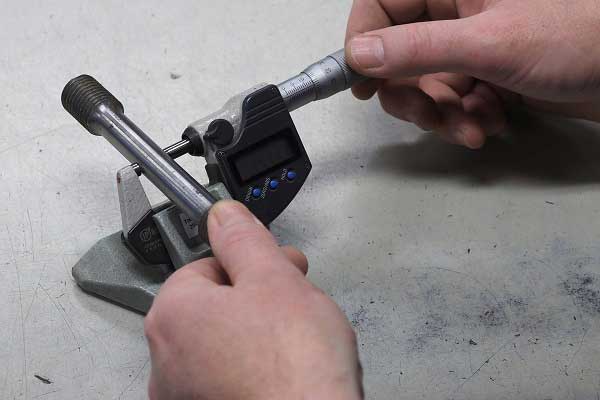
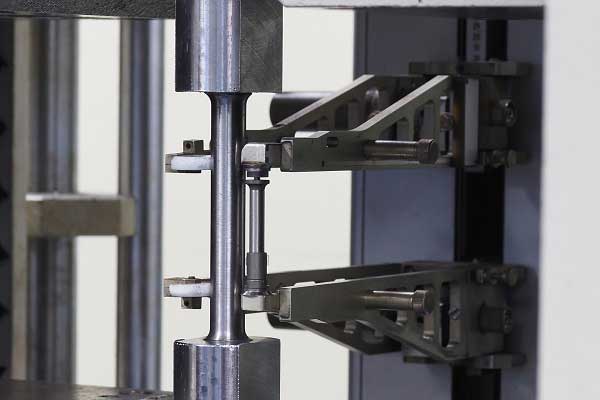
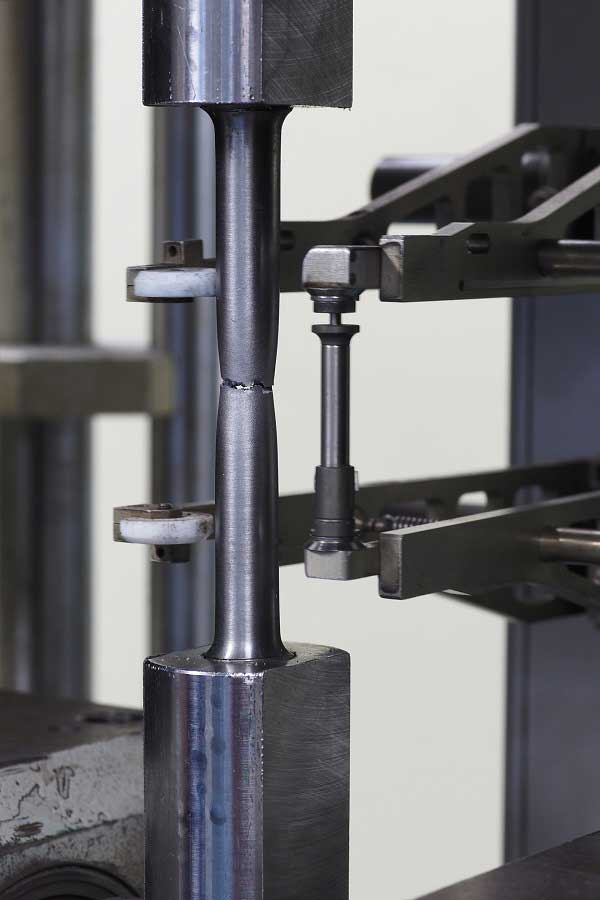
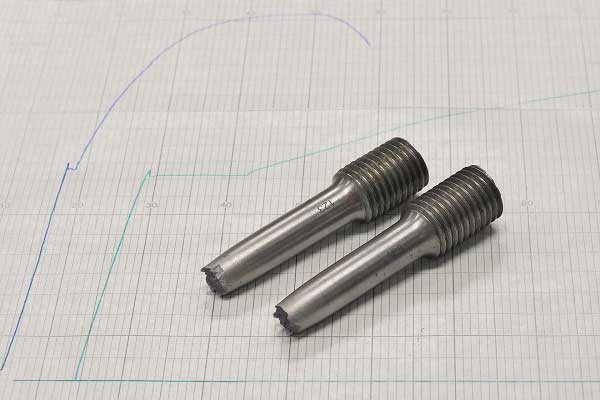 Images: www.avezaatstaal.nl
Images: www.avezaatstaal.nl